Opportunity Assessment of Virtual Power Plant Implementation for Sustainable Renewable Energy Development in Indonesia Power System Network
Abstract
:1. Introduction
2. Fundamental Concept of Virtual Power Plant
2.1. Definition and Classification of VPP
2.2. Comparison of VPP with Other Energy Management Concepts
2.3. VPP Applications and Benefits
2.3.1. Capacity Service Provider
- Portfolio management. A VPP can be used as the documentation/track record of the energy production/consumption of an organization, or what is known as a management portfolio, which is useful in balancing energy use and electrical energy production.
- Wholesale market trading. A VPP can be applied to the electric energy market by participating in the same way conventional power plants are. A VPP can send electrical energy according to a predetermined schedule, either in the forward market (long-term transactions), day-ahead market, or intraday market.
- Contract optimization. A VPP can be an energy contract optimizer between consumers and electrical energy providers. The reason is that a VPP can play a role in managing the production/consumption of electrical energy from customers to negotiate contracts optimally.
2.3.2. Ancillary Service Provider
- Assistance services for Transmission System Operator (TSO). This service includes frequency and voltage regulation, congestion management, and black start services because the VPP controls the demand or power supplies and generates units that can be started without assistance, which can be applied when a black-out occurs.
- Assistance services for Distribution System Operator (DSO). The DSO is responsible for ensuring reliable and efficient distribution grid operations. The DSO can incentivize VPPs that limit electricity demand or power supplies to a pre-agreed load value or supply level or even provide returns to VPPs that maintain an atypical grid usage profile. Thus, periods with a high load demand can be shifted toward off-peak times locally. In contrast, periods with high supply can be shifted toward peak load times, resulting in load balancing in the distribution system. DSOs can incentivize this behavior through a price-based approach. However, DSOs lack a price-based elaboration system. Thus, DSOs must primarily organize their networks locally through bilateral contracts, which may include VPPs as additional targets. An ancillary service market can be utilized to streamline incentive-based mechanisms.
2.3.3. Other VPP Functions
- Capacity mechanism. This function is defined as additional mechanisms that influence the installed capacity of generators for long-term generation needs to meet peak load requirements. Current capacity mechanisms may generally focus on conventional generation and demand response. However, because a VPP can provide electrical power generation capacity and load reduction, a VPP has the potential to participate in various capacity mechanisms in the future.
- Flexibility market. This type of market is considered to be one in which flexibility units are traded, and the products are characterized according to technical parameters, such as the maximum capacity and frequency of plant activation. It is quite attractive for all entities in the electricity market that are required to optimize scheduling and dispatch across their portfolio and for grid operators that need to attract flexibility for services, such as TSOs and DSOs.
2.4. Components of VPP
2.4.1. Distributed Energy Resources (DERs)
2.4.2. Virtual Power Plant Control Center (VPPCC)
2.4.3. Information and Communication Technology (ICT)
2.5. VPP Implementation around the World
3. Method of Gap Analysis for VPP Implementation
3.1. VPP Implementation Criteria
3.1.1. Legal Aspect
3.1.2. Technical Aspect
- The DER components that must be available in a VPP can consist of a DG, an ESS, and a DSM. The DG in the VPP can be RE, and a non-RE-based VPP can be implemented if at least two optimally operated DER units can be combined to form a dispatchable electrical energy-producing entity. For this basis, an ESS is generally necessary to deploy a VPP, especially if the type of DG available is a variable type of generation (compulsory). An ESS can be disregarded, however, if the available DG is already dispatchable (such as biomass, wind, or MHP). As such, the DSM can be optional; its existence will give greater operational flexibility to the VPP.
- A VPPCC, in a more straightforward context, can be considered an EMS equipped with communication, monitoring, control, and optimization features and is an entity that must be available to implement a VPP (compulsory). The VPPCC must be able to communicate with grid operators or load control centers in the power system in addition to communicating with VPP parties, such as DER owners, ESS providers, or DMS participant customers.
- ICT enables communication between the VPPCC and VPP parties, system operators, and policymakers (ISO). In addition, ICT can provide forecasting and scheduling functionalities by exploiting various algorithms and historical data, such as load profile data, generation profile data, or weather profile data that influences VPP operations. ICT is compulsory in the implementation of a VPP.
3.1.3. Economic Aspect
- Allowing IPPs and consumers to participate in the energy market.
- A profit-sharing system or incentive and punishment system for the IPP, consumer, or associated VPP operator.
3.1.4. Social Aspect
3.2. Weight of Compulsoriness for VPP Implementation Criteria
- Each criterion is compared with the other based on the necessity. If one criterion is more compulsory than the other criteria for the VPP implementation, it will be given a mark of one. Otherwise, it will be given a mark of zero.
- If two criteria are both compulsory, they must be assessed based on the existence of alternatives that may replace them. A criterion that has an alternative is regarded as less compulsory.
3.3. Current Electricity Status in Indonesia
3.4. Gap Analysis for VPP Implementation in Indonesia
4. Recommendation for VPP Implementation in Indonesia
4.1. Guideline and Timeline for VPP Implementation in Indonesia
4.2. Proof of Concept Implementation
4.3. Pilot Project Recommendations
5. Conclusions and Further Study
- Study the development and planning of VPP implementation policies in Indonesia. In the initial years of VPP implementation, this study is essential for establishing legal standing for VPP operations in Indonesia, covering business schemes, developers, operators, and other supporting regulations intended for VPP operations.
- Study of the development of road map implementation for a VPP in Indonesia.
Author Contributions
Funding
Institutional Review Board Statement
Informed Consent Statement
Data Availability Statement
Conflicts of Interest
References
- Baron, R. Energy Transition after the Paris Agreement: Policy and Corporate Challenges. In Proceedings of the 34th Round Table on Sustainable Development, WindEurope Summit, Hamburg, Germany, 28–29 September 2016; pp. 28–29. [Google Scholar]
- Government of the Republic of Indonesia. Indonesia Long-Term Strategy for Low Carbon and Climate Resilience 2050 (Indonesia LTS-LCCR 2050); Ministry of Environment and Forestry: Jakarta, Indonesia, 2021.
- Institute for Essential Services Reform. Indonesia Energy Transition Outlook 2022. Tracking Progress of Energy Transition in Indonesia: Aiming for Net-Zero Emissions by 2050; Institute for Essential Services Reform: Jakarta, Indonesia, 2021. [Google Scholar]
- IRENA. Renewable Power Generation Costs in 2021; IRENA: Abu Dhabi, United Arab Emirates, 2022. [Google Scholar]
- IEA. Enhancing Indonesia’s Power System Pathways to Meet the Renewables Targets in 2025 and Beyond; IEA: Paris, France, 2022. [Google Scholar]
- Sarmiento-Vintimilla, J.C.; Torres, E.; Larruskain, D.M.; Pérez-Molina, M.J. Applications, Operational Architectures and Development of Virtual Power Plants as a Strategy to Facilitate the Integration of Distributed Energy Resources. Energies 2022, 15, 775. [Google Scholar] [CrossRef]
- Koraki, D.; Strunz, K. Wind and Solar Power Integration in Electricity Markets and Distribution Networks Through Service-Centric Virtual Power Plants. IEEE Trans. Power Syst. 2017, 33, 473–485. [Google Scholar] [CrossRef]
- Chawla, Y.; Kowalska-Pyzalska, A.; Widayat, W. Consumer Willingness and Acceptance of Smart Meters in Indonesia. Resources 2019, 8, 177. [Google Scholar] [CrossRef]
- Fadli, M.; Maharani, D.P.; Liemanto, A. The Future of Sustaining Energy Using Virtual Power Plant: Challenges and Opportunities for More Efficiently Distributed Energy Resources in Indonesia. In Proceedings of the 2018 International Conference on Energy and Mining Law (ICEML 2018), Jakarta, Indonesia, 18–19 September 2018; Atlantis Press: Paris, France, 2018. [Google Scholar]
- Ullah, Z.; Arshad; Nikahi, A. Virtual Power Plant Challenges, Opportunities and Targets Analysis in the Current Electricity Markets. In Proceedings of the 2023 5th Global Power, Energy and Communication Conference (GPECOM), Cappadocia, Türkiye, 14–16 June 2023; IEEE: Piscataway, NJ, USA, 2023; pp. 370–375. [Google Scholar]
- Elgamal, A.H.; Vahdati, M.; Shahrestani, M. Assessing the Economic and Energy Efficiency for Multi-Energy Virtual Power Plants in Regulated Markets: A Case Study in Egypt. Sustain. Cities Soc. 2022, 83, 103968. [Google Scholar] [CrossRef]
- Awerbuch, S.; Preston, A. The Virtual Utility: Accounting, Technology & Vompetitive Aspects of the Emerging Industry; Springer Science & Business Media: Berlin/Heidelberg, Germany, 2012; Volume 26, ISBN 1461561671. [Google Scholar]
- Wang, X.; Liu, Z.; Zhang, H.; Zhao, Y.; Shi, J.; Ding, H. A Review on Virtual Power Plant Concept, Application and Challenges. In Proceedings of the 2019 IEEE PES Innovative Smart Grid Technologies Conference—Latin America (ISGT Latin America), Chengdu, China, 15–18 September 2019; pp. 4328–4333. [Google Scholar]
- Zhang, G.; Jiang, C.; Wang, X. Comprehensive Review on Structure and Operation of Virtual Power Plant in Electrical System. IET Gener. Transm. Distrib. 2019, 13, 145–156. [Google Scholar] [CrossRef]
- Asmus, P. VPPs and DERMSs: Different Sides to the Same Coin; Navigant Consulting, Inc.: Chicago, IL, USA, 2018. [Google Scholar]
- Roozbehani, M.M.; Heydarian-Forushani, E.; Hasanzadeh, S.; Elghali, S. Ben Virtual Power Plant Operational Strategies: Models, Markets, Optimization, Challenges, and Opportunities. Sustainability 2022, 14, 12486. [Google Scholar] [CrossRef]
- Plancke, G.; De Vos, K.; Belmans, R.; Delnooz, A. Virtual Power Plants: Definition, Applications and Barriers to the Implementation in the Distribution System. In Proceedings of the 2015 12th International Conference on the European Energy Market (EEM), Lisbon, Portugal, 19–22 May 2015; IEEE: Piscataway, NJ, USA, 2015; pp. 1–5. [Google Scholar]
- Ullah, Z.; Mokryani, G.; Campean, F.; Hu, Y.F. Comprehensive Review of VPPs Planning, Operation and Scheduling Considering the Uncertainties Related to Renewable Energy Sources. IET Energy Syst. Integr. 2019, 1, 147–157. [Google Scholar] [CrossRef]
- Zajc, M.; Kolenc, M.; Suljanović, N. Virtual Power Plant Communication System Architecture. In Smart Power Distribution Systems; Elsevier: Amsterdam, The Netherlands, 2019; pp. 231–250. [Google Scholar]
- Li, B.; Wang, J.; Bai, X.; Tang, T.; Zhao, J.; Liu, C.; Hou, Z.; Banimenia, I.; Ali, R. Overview and Prospect of Information and Communication Technology Development in Virtual Power Plants. Energy Convers. Econ. 2022, 3, 368–380. [Google Scholar] [CrossRef]
- Marinescu, B.; Gomis-Bellmunt, O.; Dörfler, F.; Schulte, H.; Sigrist, L. Dynamic Virtual Power Plant: A New Concept for Grid Integration of Renewable Energy Sources. IEEE Access 2022, 10, 104980–104995. [Google Scholar] [CrossRef]
- Applied Economics Clinic. ConnectedSolutions A Program Assessment for Massachussets; Clean Energy Group: Montpellier, France, 2021. [Google Scholar]
- Green Mountain Power. 2021 Integrated Resource Plan; Green Mountain Power: Colchester, UK, 2023. [Google Scholar]
- Armitage, M. AEMO NEM Virtual Power Plant Demonstrations Knowledge Sharing Report #4; Australian Energy Market Operator Ltd.: Melbourne, Australia, 2021. [Google Scholar]
- MERLON. MERLON Products and Solutions—Clean & Secure Electricity for an Energy Island in Austria; MERLON: Strem, Austria, 2022. [Google Scholar]
- Marchment Hill Consulting. Simply Energy VPPX ARENA Stage 1 Knowledge Sharing Report; Australian Renewable Energy Agency: Canberra, Australia, 2019.
- Eisner, A.; Neumann, C.; Tuerk, A. Energy Communities and Energy Poverty Mitigation: Quantitative Assessments of Cases in Portugal and Spain; COMPILE Project: Ljubljana, Slovenia, 2022; Available online: https://main.compile-project.eu/wp-content/uploads/COMPILE-Working-paper_Energy-poverty_Nov2022.pdf (accessed on 7 January 2024).
- MUSE-GRIDS. WP2—“Smart Control for Multiple Energy Grids Integration on Generation, Storage, Demands Levels” D2.9—“Guidelines for Smart Controller Deployment at the Demos”; Multi Utilities Smart Energy GRIDS. 2022. Available online: https://muse-grids.eu/wp-content/uploads/2021/03/D2.9-Guidelines-for-smart-controller-deployment-at-the-demos.pdf (accessed on 7 January 2024).
- AGL Energy. Virtual Power Plant in South Australia Final Milestone Report; Australian Gas Light Company: Sydney, Australia, 2020. [Google Scholar]
- Valarezo, O.; Gómez, T.; Chaves-Avila, J.P.; Lind, L.; Correa, M.; Ulrich Ziegler, D.; Escobar, R. Analysis of New Flexibility Market Models in Europe. Energies 2021, 14, 3521. [Google Scholar] [CrossRef]
- InteGRIDy Integrated Smart GRID Cross-Functional Solutions for Optimized Synergetic Energy Distribution, Utilization Storage Technologies. Available online: https://www.integridy.eu/ (accessed on 7 January 2024).
- WindNODE. Showcasing Smart Energy Systems from Northeastern Germany; WindNODE Project Management: Berlin, Germany, 2020. [Google Scholar]
- Chen, T.; Cui, Q.; Gao, C.; Hu, Q.; Lai, K.; Yang, J.; Lyu, R.; Zhang, H.; Zhang, J. Optimal Demand Response Strategy of Commercial Building—Based Virtual Power Plant Using Reinforcement Learning. IET Gener. Transm. Distrib. 2021, 15, 2309–2318. [Google Scholar] [CrossRef]
- Tesla Motors Australia. South Australia Virtual Power Plant Phase 3A Knowledge Sharing Report; Tesla Motors Australia Pty. Ltd. (Tesla): Cremorne, Australia, 2021. [Google Scholar]
- SmarterEMC2. Smarter Grid: Empowering SG Market Actors through Information and Communication Technologies; European Commission: Athens, Greece, 2022. [Google Scholar]
- Shad, M.; Momeni, A.; Errouissi, R.; Diduch, C.P.; Kaye, M.E.; Chang, L. Identification and Estimation for Electric Water Heaters in Direct Load Control Programs. IEEE Trans. Smart Grid 2015, 8, 947–955. [Google Scholar] [CrossRef]
- Binding, C.; Gantenbein, D.; Jansen, B.; Sundström, O.; Andersen, P.B.; Marra, F.; Poulsen, B.; Træholt, C. Electric Vehicle Fleet Integration in the Danish EDISON Project—A Virtual Power Plant on the Island of Bornholm. In Proceedings of the IEEE PES General Meeting, Minneapolis, MN, USA, 25–29 July 2010; IEEE: Piscataway, NJ, USA, 2010; pp. 1–8. [Google Scholar]
- Corera, J.M. The FENIX Project: Integration of Renewables and Distributed Generation in Networks through Aggregation. In Proceedings of the CIRED 2009—The 20th International Conference and Exhibition on Electricity Distribution-Part 2, Prague, Czech Republic, 8–11 June 2009; IET: London, UK, 2009; pp. 1–16. [Google Scholar]
- Chugh, G.; Singh, P.K.; Dwivedi, S.; Mackensen, R.; Liebehentze, S. Opportunities for Virtual Power Plants in India; Deutsche Gesellschaft für Internationale Zusammenarbeit: New Delhi, India, 2019. [Google Scholar]
- Bhuiyan, E.A.; Hossain, M.Z.; Muyeen, S.M.; Fahim, S.R.; Sarker, S.K.; Das, S.K. Towards next Generation Virtual Power Plant: Technology Review and Frameworks. Renew. Sustain. Energy Rev. 2021, 150, 111358. [Google Scholar] [CrossRef]
- Nwauka, O.; Telukdarie, A.; Enslin, J. Virtual Power Plant Basic Requirements for Integration of Distributed Energy Resources, Driven by Industry 4.0. IEOM 2018, 2, 511–523. [Google Scholar]
- Jadhav, A.; Sonar, R. Analytic Hierarchy Process (AHP), Weighted Scoring Method (WSM), and Hybrid Knowledge Based System (HKBS) for Software Selection: A Comparative Study. In Proceedings of the 2009 Second International Conference on Emerging Trends in Engineering & Technology, Nagpur, India, 16–18 December 2009; IEEE: Piscataway, NJ, USA, 2009; pp. 991–997. [Google Scholar]
- McNeil, M.A.; Karali, N.; Letschert, V. Forecasting Indonesia’s Electricity Load through 2030 and Peak Demand Reductions from Appliance and Lighting Efficiency. Energy Sustain. Dev. 2019, 49, 65–77. [Google Scholar] [CrossRef]
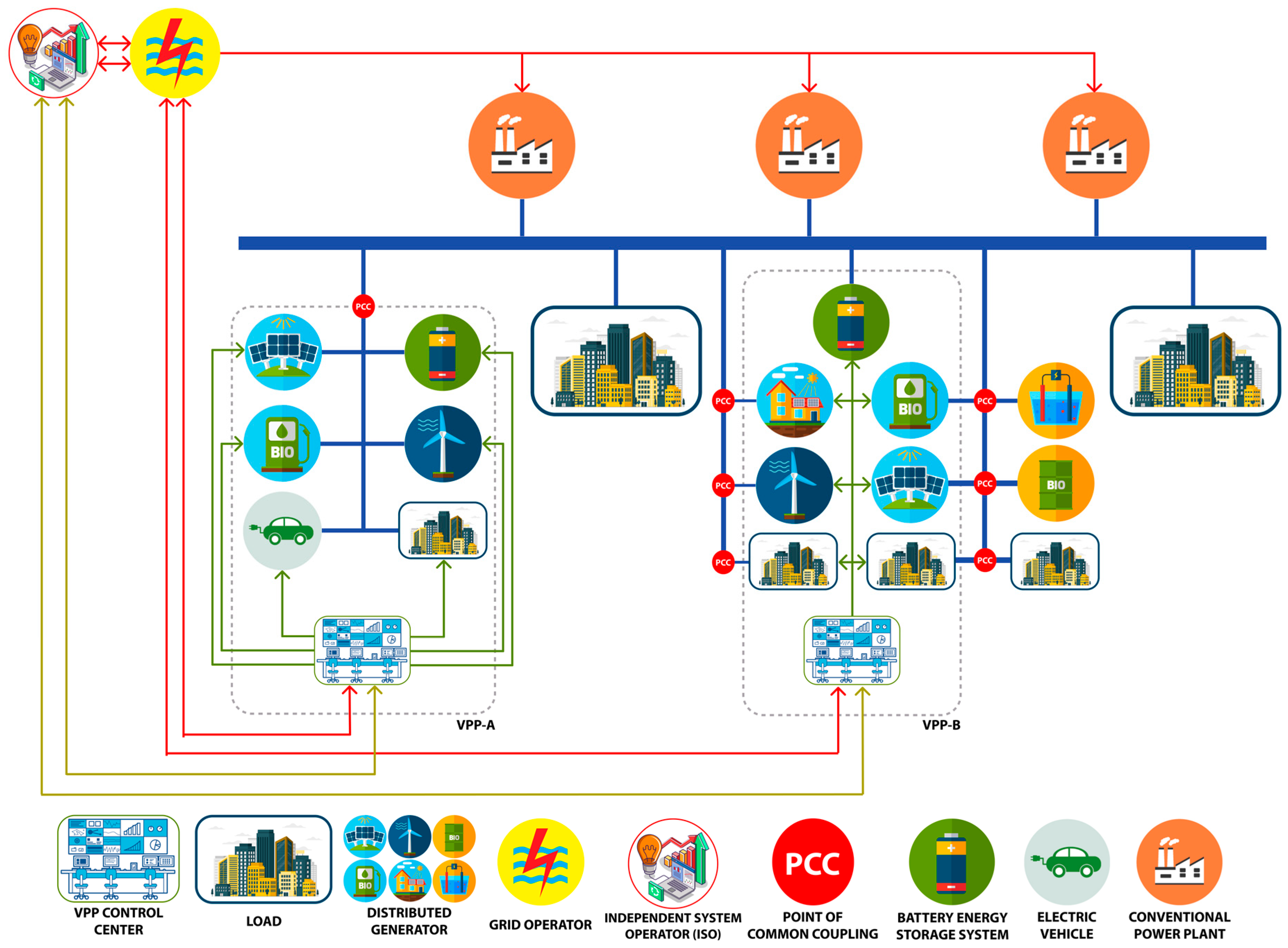
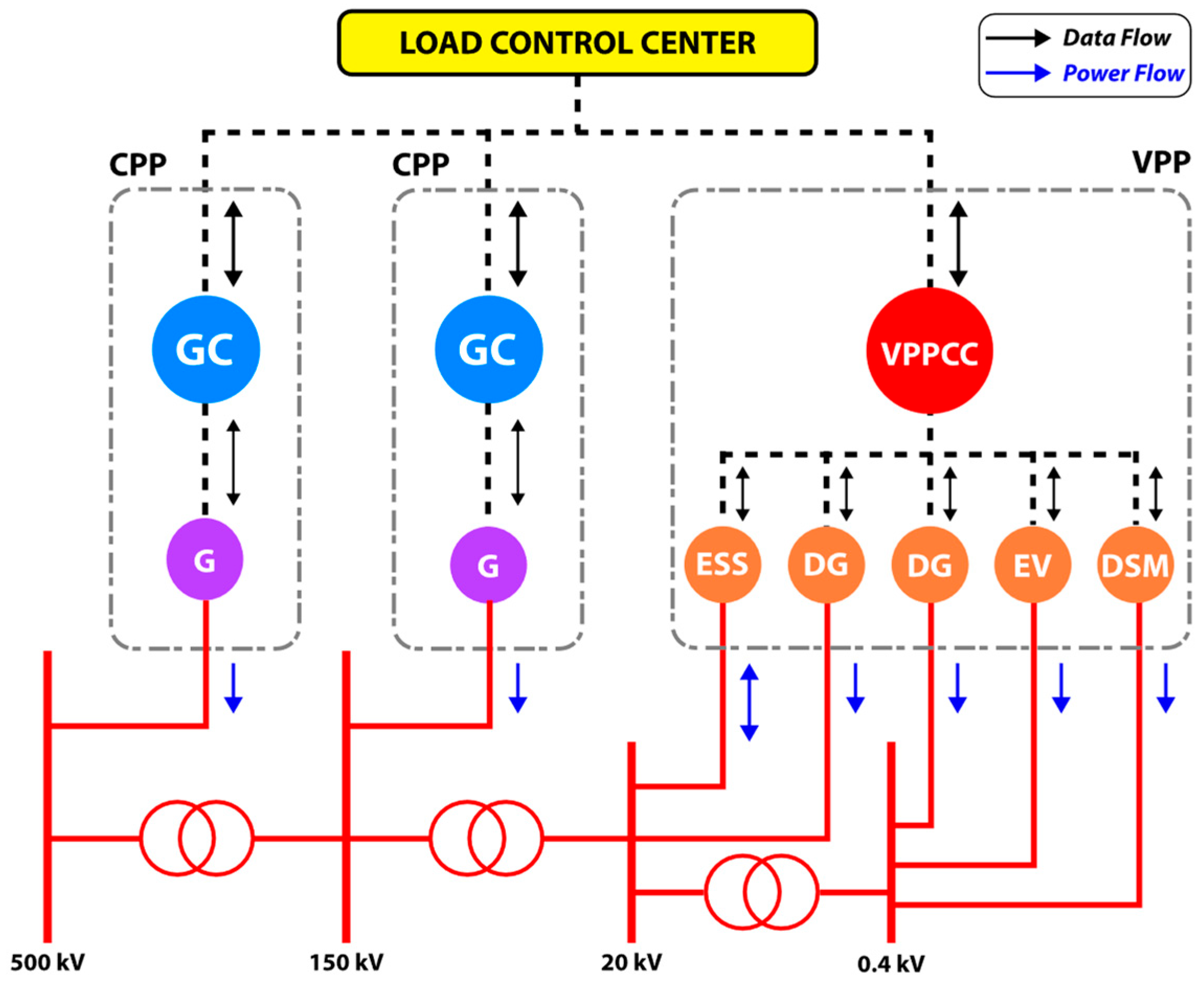
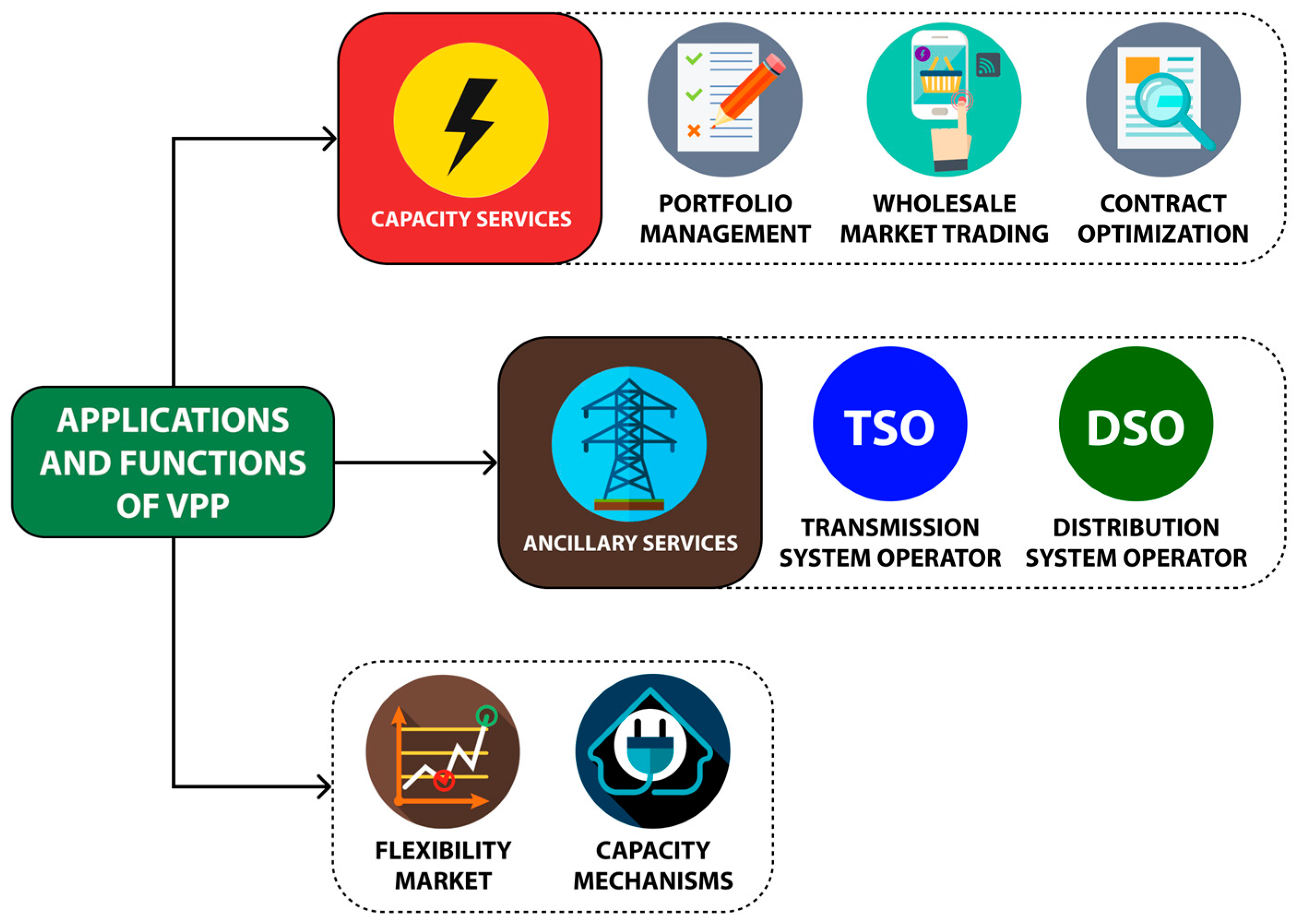

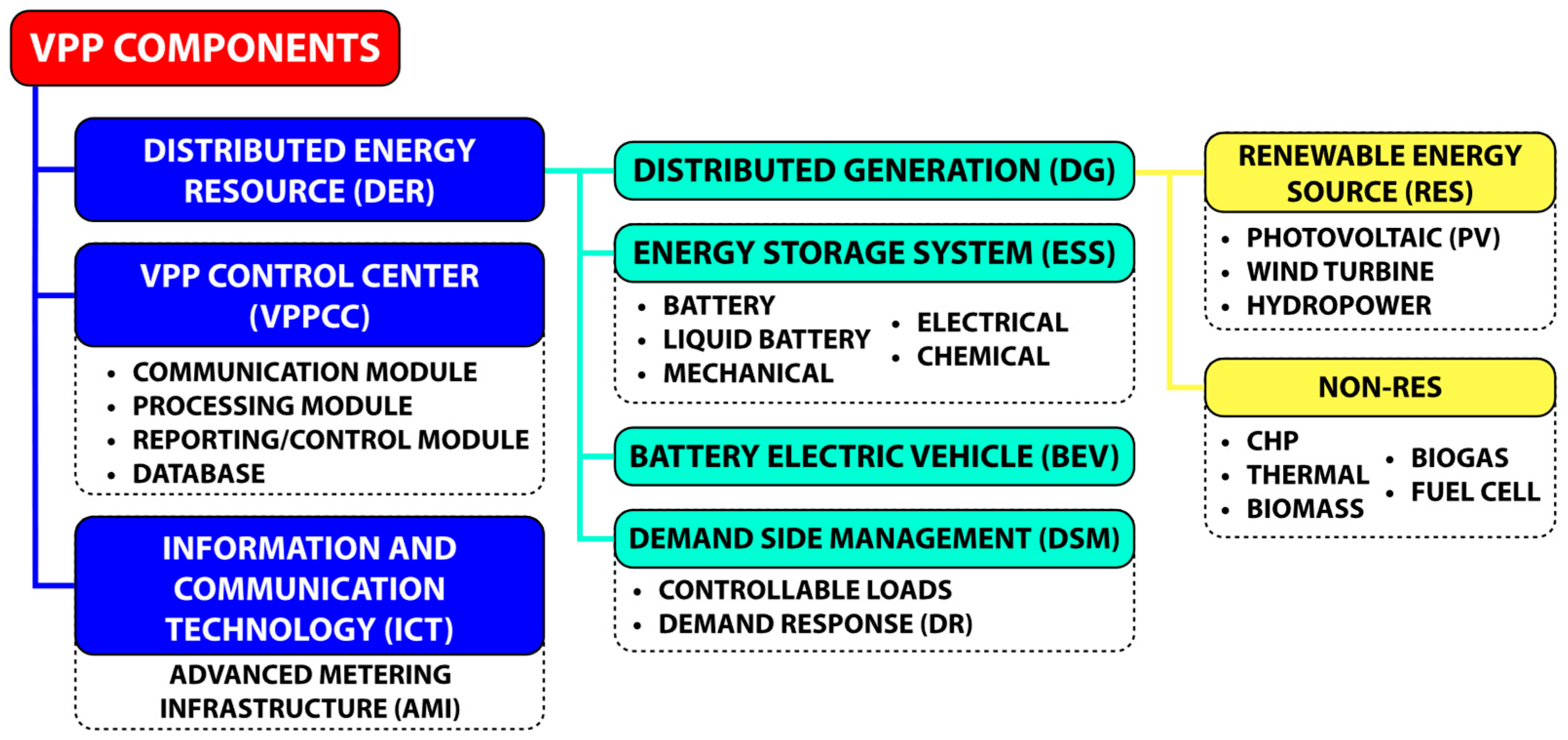

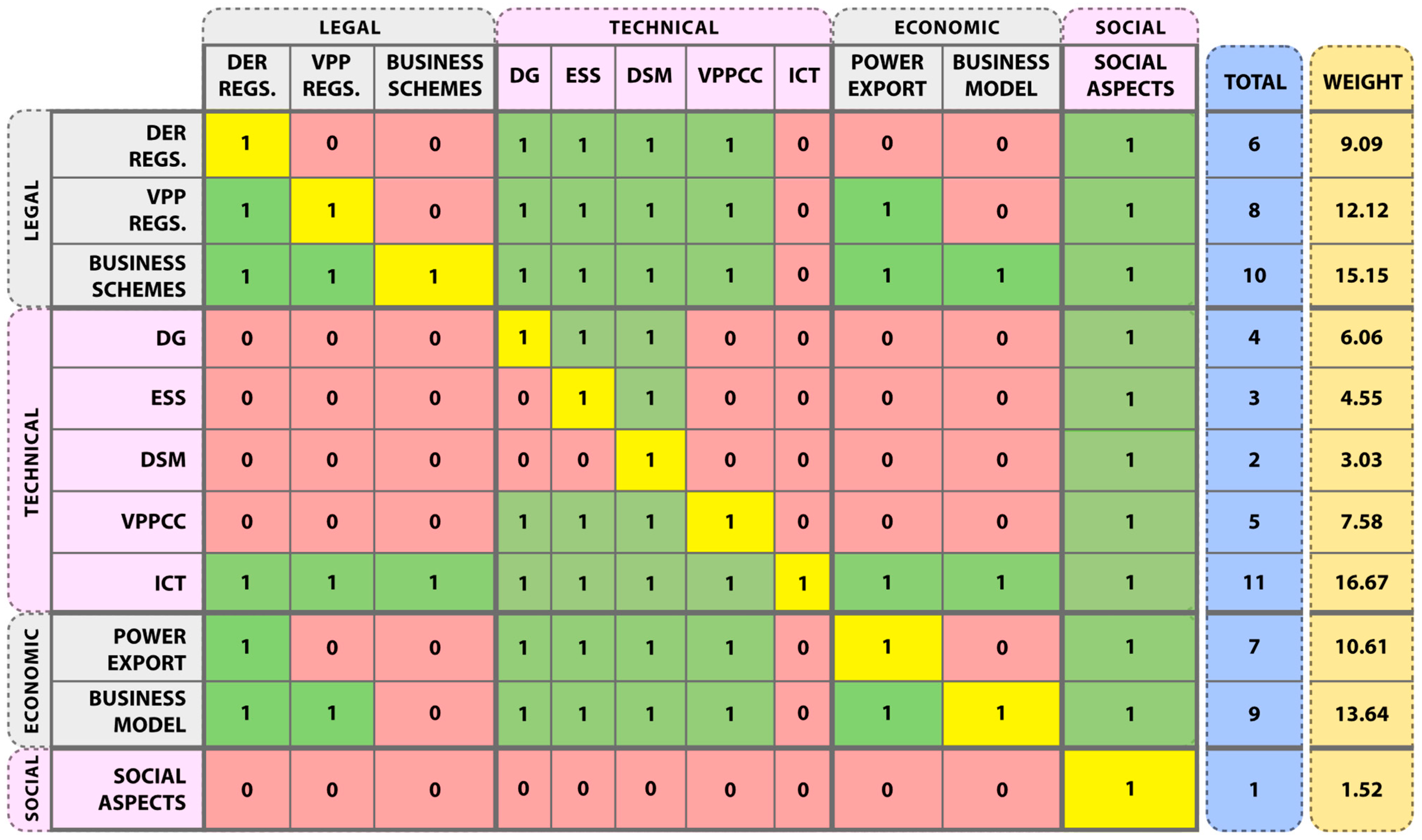


| Comparison | VPP | DERMS | Microgrid | CPP |
|---|---|---|---|---|
| Definition | DG aggregation to be able to operate like a single power plant | DG aggregation to be able to operate like a single power plant | Generation and load cluster like a power system | Single power generation entity |
| Physical/Geographical Boundary Requirement | Unnecessary | Unnecessary | Unnecessary | Clearly defined |
| Components | DG, flexible loads, BESS, EV, and VPPCC | DG, BESS, and DERMS | DG, flexible loads, BESS, EV, and MGCC | Generators with certain types of energy sources |
| Players | Aggregator, grid operator, DER provider, and ISO | Aggregator, grid operator, DER provider, and ISO | Aggregator, grid operator, DER provider, and ISO | Utility company or Independent Power Producer (IPP) |
| Functional Focus | DG management in groups and participating together in the energy market | DG management in groups for operational ease | Independent energy management in its own cluster | Power generation |
| Application | Energy capacity provider and ancillary service | Energy capacity provider and ancillary service | Energy capacity provider | Energy capacity provider and ancillary service |
| Association with Grid | Grid-connected, and two-way power, data, and cash flow | Grid-connected, two-way power and data flow, and one-way cash flow | Grid-connected or islanded, and two-way power, data, and cash flow | Grid-connected, two-way data flow, and one-way power and cash flow |
| Topology | Using utility networks (distribution and transmission) | Using utility networks (distribution and transmission) | Generally using distribution networks | Using utility networks (distribution and transmission) |
| Energy Market | Tends to be more optimal in a liberalized market | Can be implemented in a non-liberalized market | Can be implemented in a non-liberalized market | Can be implemented in a non-liberalized market |
| Expansion Flexibility | Flexible | Flexible | Flexible | Less flexible |
| Project Name | Location | Year | Capacity and Quantity Description | Reference |
|---|---|---|---|---|
| POSYTYF Project | Spain, France, Switzerland, Germany | 2020–2023 | 2446 MW (Type I—Isolated with Storage), 21,512 MW (Type II—AC Interconnected— Northern Europe); PV, Wind, Thermal, Hydro | [21] |
| ConnectedSolution: National Grid and Eversource | Massachusetts, USA | 2019–now | 310 MW; 34,105 Consumers | [22] |
| Resilient Homes: Green Mountain Power | Vermont, USA | 2019–now | 60 MW; 269,000 Consumers | [23] |
| AEMO VPP Demonstrations | Australia | 2019–2022 | 31 MW/8 DERs (PV, BESS, DR); 7150 Consumers | [24] |
| MERLON | Spain, Austria, Ireland, UK, Netherlands, Greece | 2019–2022 | 250 kW (Güssing/Strem, Austria); 574 Consumers | [25] |
| Simply Energy VPP | Australia | 2018–2023 | 6 MW BESS + 2 MW DR/1200 DERs; 700,000 Consumers | [26] |
| COMPILE | Slovenia, Spain, Croatia, Portugal, Greece | 2018–2022 | 13.4 MW/77,000 DERs (Crevillent, Spain); 9 kW/150 DERs (Lisbon, Portugal); 60 kW (Križevci, Croatia); 14,315 Consumers (Crevillent, Spain); 400 Consumers (Lisbon, Portugal) | [27] |
| MUSE-GRIDS | Italy, Belgium, Ireland, Spain, Greece, Netherlands, Denmark, Israel | 2018–2022 | 33.8 MW (Osimo, Italy); 65 kW (Oud-Heverlee, Belgium); 30,216 Consumers (Osimo, Italy) | [28] |
| Consolidated Edison | New York, USA | 2018–2020 | 100–300 MW/1000 DERs (PV, ESS); 3,300,000 Consumers | [13] |
| AGL VPP | Australia | 2017–2022 | 5 MW/1000 DERs (PV, BESS) | [29] |
| EU-SysFlex | Germany, Italy, Finland, Portugal, France, Estonia | 2017–2021 | Specific data are not available | [30] |
| inteGRIDy | UK, Italy, Romania, Greece, Spain, Portugal, France | 2017–2020 | 28.8 MW/417 DERs (San Severino, Italy); 7900 Consumers (San Severino, Italy) | [31] |
| WindNODE | Germany | 2017–2020 | Peak Load: 16 GW; Installed Renewables: 33 GW (2018); 16,200,000 Consumers | [32] |
| Shanghai Huangpu District VPP Project | People’s Republic of China | 2016– unknown | 50 MW + 10 MW of DR + 2 MW of Frequency Regulation; 300 Consumers (Buildings) | [33] |
| South Australia VPP | Australia | 2016–2019 | 250 MW/1000 DERs (PV, BESS); 50,000 Consumers | [34] |
| SmarterEMC2 | Italy, Greece, Turkey, UK, Portugal | 2015–2017 | Specific data are not available | [35] |
| PowerShift Atlantic | Canada | 2010–2015 | 17.3 MW; 1400 Consumers | [36] |
| Smartpool | Germany | 2009–now | 12,294 MW/15,346 DERs (PV, Wind, Hydropower, Bioenergy) | [6] |
| Web2Energy | Germany | 2009–2015 | 40.5 MW/16 DERs (CHP, PV, Wind, Biogas, Hydropower); 200 Consumers | [13] |
| Edison Project | Bornholm Island, Denmark | 2009–2012 | 125 MW/52 DERs; 27,000 Consumers | [37] |
| FENIX | UK, Spain, France | 2005–2009 | 1000–1,000,000 DERs (μ-CHP, PV, Wind); 169,000 Consumers | [38] |
| Criteria | Current Status (1: Exist; 0: Not Exist) | Weight (%) | Weighted Score (%) |
|---|---|---|---|
| Legal: DER Regulations | 1 | 9.09 | 9.09 |
| Legal: VPP Regulations | 0 | 12.12 | 0 |
| Legal: Business Schemes | 0 | 15.15 | 0 |
| Technical: DG | 1 | 6.06 | 6.06 |
| Technical: ESS | 1 | 4.55 | 4.55 |
| Technical: DSM | 0 | 3.03 | 0 |
| Technical: VPPCC | 0 | 7.58 | 0 |
| Technical: ICT | 1 | 16.67 | 16.67 |
| Economic: Power Export | 1 | 10.61 | 10.61 |
| Economic: Business Model | 0 | 13.64 | 0 |
| Social Aspects | 0 | 1.52 | 0 |
| Total | 100 | 46.97 | |
Disclaimer/Publisher’s Note: The statements, opinions and data contained in all publications are solely those of the individual author(s) and contributor(s) and not of MDPI and/or the editor(s). MDPI and/or the editor(s) disclaim responsibility for any injury to people or property resulting from any ideas, methods, instructions or products referred to in the content. |
© 2024 by the authors. Licensee MDPI, Basel, Switzerland. This article is an open access article distributed under the terms and conditions of the Creative Commons Attribution (CC BY) license (https://creativecommons.org/licenses/by/4.0/).
Share and Cite
Setiawan, A.; Jufri, F.H.; Dzulfiqar, F.; Samual, M.G.; Arifin, Z.; Angkasa, F.F.; Aryani, D.R.; Garniwa, I.; Sudiarto, B. Opportunity Assessment of Virtual Power Plant Implementation for Sustainable Renewable Energy Development in Indonesia Power System Network. Sustainability 2024, 16, 1721. https://doi.org/10.3390/su16051721
Setiawan A, Jufri FH, Dzulfiqar F, Samual MG, Arifin Z, Angkasa FF, Aryani DR, Garniwa I, Sudiarto B. Opportunity Assessment of Virtual Power Plant Implementation for Sustainable Renewable Energy Development in Indonesia Power System Network. Sustainability. 2024; 16(5):1721. https://doi.org/10.3390/su16051721
Chicago/Turabian StyleSetiawan, Agus, Fauzan Hanif Jufri, Fatih Dzulfiqar, Muhammad Gillfran Samual, Zainal Arifin, Fahmi Firdaus Angkasa, Dwi Riana Aryani, Iwa Garniwa, and Budi Sudiarto. 2024. "Opportunity Assessment of Virtual Power Plant Implementation for Sustainable Renewable Energy Development in Indonesia Power System Network" Sustainability 16, no. 5: 1721. https://doi.org/10.3390/su16051721
APA StyleSetiawan, A., Jufri, F. H., Dzulfiqar, F., Samual, M. G., Arifin, Z., Angkasa, F. F., Aryani, D. R., Garniwa, I., & Sudiarto, B. (2024). Opportunity Assessment of Virtual Power Plant Implementation for Sustainable Renewable Energy Development in Indonesia Power System Network. Sustainability, 16(5), 1721. https://doi.org/10.3390/su16051721





